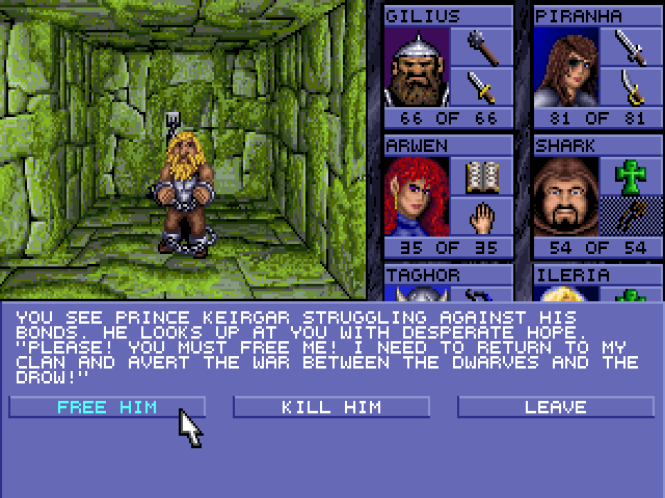Eye of the Beholder was a point-of-no-return for me when it came to RPGs, it looked like a deep and complex game with stunning visuals and a gripping atmosphere. I had never heard of anything called Dungeons & Dragons before this, and in hindsight the EotB game served as a wonderful gateway game into that realm. The intro blew me away as it laid down the plot: A party of adventurers is sent to look for an evil presence within the city of Waterdeep and told to start in the sewers. The game mesmerized me so much that I didn’t stop to ask “Wait, sewers?” but was instead eager to start my adventure and see where it would take me.
Eye of the Beholder’s character creation appeared both simple and complex at the same time, but it wasn’t until much later that I realized why that was; the developers decided to merely use the AD&D rules as a guideline instead of wrapping the game in them. Turns out that half of the main stats are useless and many smaller rules are either ignored or hidden from the player. Looking back on that I can imagine that hardcore roleplayers would be miffed, but to a newcomer like myself it was perfect. I did as the manual suggested and created a mixed party of 4 characters that could deal with whatever dangers lay ahead, knowing that I could recruit 2 NPCs in-game if something went wrong.
Once the game starts it won’t take long to get immersed in the game’s atmosphere. Bare bones piled up in the corner and glowing eyes staring at me from a sewer grate. No music is played beyond the title screen, which left me only with environmental sounds to break the silence. A few minutes of checking my gear and looking around led me face to face with my first monster. That little kobold sure had a vicious glint in his eyes. I was familiar with older games telling me in plain text what monsters I had encountered, but here I saw first-hand that I was facing one murderous kobold, and that I had to act fast to deal with him as EotB is real-time, after all.
The game’s design firmly points to “figure things out for yourself”. Except for a crude map of the starting levels, a compass in the UI and a few vague clues gleamed from the manual, I was utterly on my own, trapped in a sewer. Even when I accidentally discovered that the game has hidden “Special Quests” I was mostly clueless as to how I triggered them. Not that I cared, I was having too much fun exploring.
At first I thought my party would never meet anyone to talk to, but as soon as I cleared the sewers and reached the levels beyond I was proven wrong. Interactions with NPCs are just walls of exposition text, but sometimes I was given a choice like should I slay the injured dwarf or spare the drow leader’s life… not that any of that mattered in the long run.
Death is never far away in Eye of the Beholder; while characters can be raised from the dead there are few opportunities to do so, especially early on. The early monsters didn’t provide much of a challenge, but then I stumbled upon that infestation of 6-foot tall spiders on Level 4 that wiped out my entire party several times due to their poisonous bites. I’m surprised I didn’t develop arachnophobia after that.
Around the time I bought the first game, the sequel Eye of the Beholder II: The Legend of Darkmoon had already been released. Having two EotB games to play simultaneously was a slice of heaven for me, as the sequel bettered the original in almost every conceivable way. When Eye of the Beholder III: Assault on Myth Drannor was released in 1993, I snapped it up immediately. While it delivered more of the same it just didn’t have the same magic touch as its predecessors. Turns out that the developer and publisher had parted ways, forcing the publisher to finish the game in-house in a hurry. It was a bad end to a great game series. Árni Víkingur




